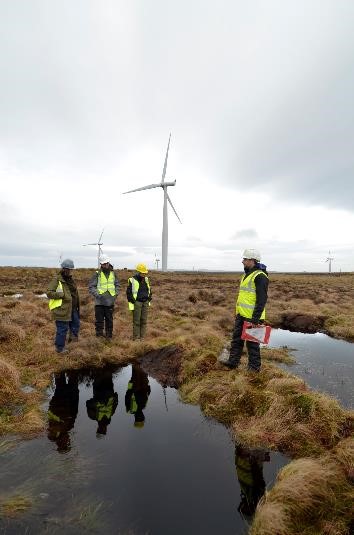Scottish Natural Heritage (SNH) Peatland ACTION and IUCN UK PP staff visited Black Law wind farm to see ScottishPower Renewables’ new ditch blocking trial.
 ScottishPower is seeking to develop a new method to deal with blocking drainage channels. An area of open bog (about 40ha in size) with a dense 23km network of drains, installed during the early 1900s, has become a trial site for a new form of peat damming developed by ScottishPower: wave damming. With no shortage of rain in the preceding weeks, brought in with Storms Gertrude and Henry, it was clear that the trial site was effective in holding water!
ScottishPower is seeking to develop a new method to deal with blocking drainage channels. An area of open bog (about 40ha in size) with a dense 23km network of drains, installed during the early 1900s, has become a trial site for a new form of peat damming developed by ScottishPower: wave damming. With no shortage of rain in the preceding weeks, brought in with Storms Gertrude and Henry, it was clear that the trial site was effective in holding water!
The main driver for developing this method was the high cost of installing plastic piling or constructing traditional peat dams across such an extensively and densely drained site. ScottishPower’s ecologists also wanted to discourage the preferential flow that can frustratingly develop around the sides of a newly installed peat dam. The ‘wave damming’ method aims to span the whole cross-section of oxidised peat either side of the cut channel and to block all hydrological flow paths: the process of wasting of peat either side of a drain channel is illustrated by Richard Lindsay in a previous IUCN Peatland briefing note on drainage impact.
Dams are installed very close together, at 3-4m spacing across the ditch. The site we looked at had small ditches, 0.8m deep with a similar width across. The dams are made by drawing in three complete buckets of peat and vegetation from either side of the drain and compressing this to form a long, wide dam. All the dams had pools behind them, usually quite deep after restoration, which were a worry for the local grazier. Minimising the amount of bare, exposed peat is a key concern. These dams have the benefit of vegetation being an integral part of the peat which is pulled in, rather than being ‘capped’ with an excavated layer of peat from elsewhere. It is hoped that this will encourage stability within the surface of the dam wall, reducing slumping and improving its longevity.
Their ecologists have worked closely with their contractors to develop a method that minimises the risk of vegetation being smothered or flipped as the dam is pulled into place. Essentially, all that is required is some dextrous movement of the digger bucket. With a little practice this can be achieved at a rate of around 1 minute 15 seconds per dam, resulting in an impressive and cost effective amount of restoration works achieved per day.
SNH’s Peatland ACTION Officers raised concern that there might be issues with leaking dams in the future as the dam material is formed from three scoops of the digger bucket to form a dam: water might leak through the joins and reduce the dam’s effectiveness. Extensive baseline monitoring has been installed across the trial area. Long term stability and performance under dry conditions are still and unknown. It is encouraging to see innovation, in what is essentially a long-established technique, and we look forward to seeing how this site develops.
Emma Goodyer
IUCN UK PP Programme Manager









